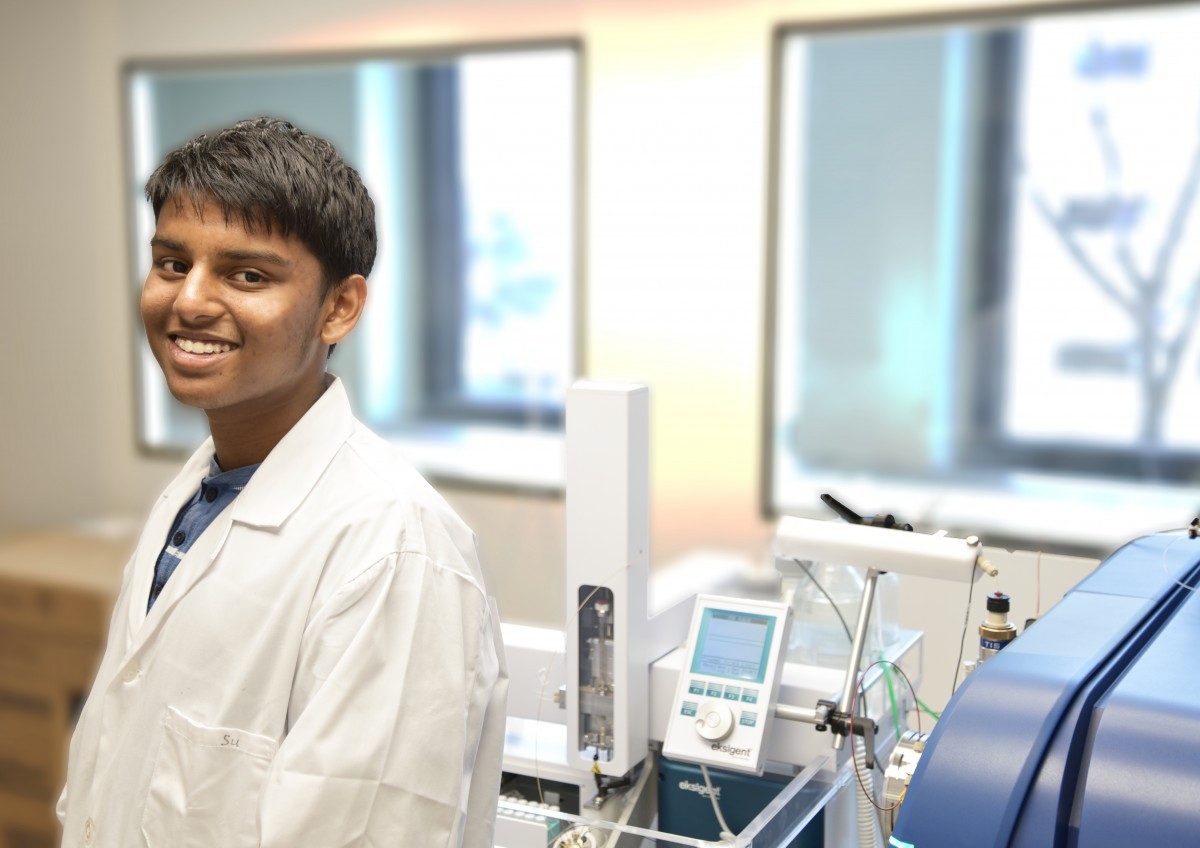
Geemitha Ratnayake
Sixteen-year-old science prodigy discovers carcinogens in soda pop and beer
Geemitha Ratnayake, a high school student from Fort Richmond Collegiate, has a bright future ahead. Already, at the age of sixteen, he has published his first scientific paper as lead author, together with Lianna Bestvater, Thor Halldorson, and Gregg T. Tomy, titled, “Determination of 4(5)-methylimidazole in carbonated beverages by isotope-dilution liquid chromatography-tandem mass spectrometry,” in the journal of Food Additives and Contaminants.
The paper examines findings involving the potentially carcinogenic chemical, 4-methylimidazole (4-MEI), found in the caramel colouring used in popular brands of soda pop and beer. The research supports findings from previous studies including a 2013 Consumer Reports (CR) commissioned study, and a report by the state of California that indicated popular alcoholic and non-alcoholic beverages contain this suspected carcinogen at levels that exceed the toxicity threshold guidelines.
“Because most people consume a can of soda pop a day, and due to the widespread use of 4-MEI, in other foods; staples that most people consume everyday like coffee and soya sauce, this research may be significant,” explains Ratnayake.
One of the popular brands of soda presented in Ratnayake’s study boasted sales in 2013 of 1.24 billion gallons of just their cola alone.
Neither Health Canada nor the U.S. Food and Drug Administration have established regulatory guidelines for 4-MEI. However, the state of California has added 4-MEI to its list of carcinogens. A recent BBC article published in February 2015, announced that due to consumer concerns, a popular brand of beer, Newcastle Brown Ale, sold in both the UK and the USA, was changing its recipe to no longer include caramel colouring.
Ratnayake was compelled to find out more after reading an article about 4-MEI as a student in junior high, and in 2013, he approached Phil Hultin in the department of chemistry at the U of M, who introduced him to two of his colleagues, Gregg Tomy and Thor Halldorson, chemists with research expertise in chemical toxicity. He was ecstatic to find out they were willing to mentor him.
As Ratnayake knew very little about chemistry, Tomy and Halldorson set about teaching him the basics of analytical chemistry. For approximately four months, Ratnayake spent six to eight hours each Saturday, enthusiastically working in the department of chemistry. There he had the opportunity to learn to use state-of-the-art equipment such as the High Performance Liquid Chromatography/ Tandem Mass Spectrometry system to determine the amount of 4-MEI in each product they tested.
“It was fascinating. I got to learn a lot, how to prepare samples properly, how to perform quality control tests, and all about the method development process,” said Ratnayake.
All that enthusiasm paid off. In 2014, Ratnayake presented his findings at the Manitoba School Science Symposium, where he won four separate awards: Best Individual Chemistry Project at the intermediate level; Analytical Sciences Award from Mid Canada Association of Analytical Chemistry, Canada Institute of Food Science and Technology and a Gold medal.
“What he has managed to accomplish is tremendous; at a graduate level, it would be considered impressive work. He is such a pleasure to teach, he is very bright and polite. His enthusiasm and desire to learn, inspires me,” remarked Tomy.
Ratnayake’s interest in 4-MEI has since expanded and he’s now exploring whether there is also a connection between 4-MEI and obesity. Working alongside Mark Fry, a neuroscientist in the department of biological sciences, Ratnayake has found that incredibly high doses of 4-MEI may potentially trigger subtle changes in brain chemistry that may lead to obesity, but further research is still needed. He presented his preliminary findings in April at the 2015 Manitoba School Science Fair.
“It has been really valuable for me, because I really enjoy learning all about these fields and science in general, and I like having the opportunity to explore the real world of science,” said Ratnayake.
When asked if he would like to attend the U of M in the future as a university student, Ratnayake remarked, “I think the University of Manitoba is a wonderful learning environment; every person that I have met who works there has been very kind to me. I think I would enjoy being a student there.”








![Beer_MSSS science fair poster - April 22nd[4]](http://news.umanitoba.ca/wp-content/uploads/2015/05/Beer_MSSS-science-fair-poster-April-22nd4-800x537.jpg)
What a great role model.